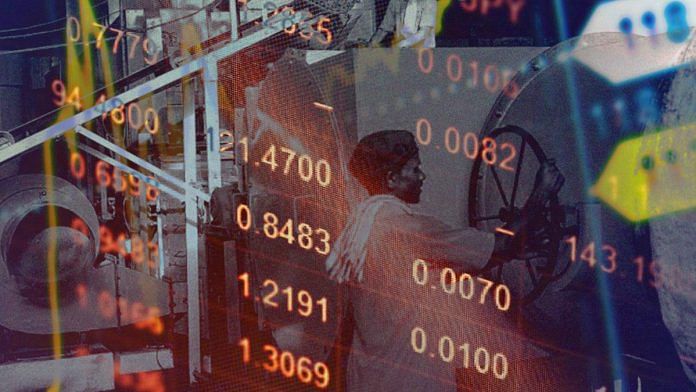New Delhi: Continuing with last year’s uncertain outlook about growth, 56 percent of chief economists expect the global economy to weaken in 2024, according to a latest World Economic Forum (WEF) report.
As the world continues to grapple with conflicts and crises, 7 in 10 economists expect geoeconomic fragmentation to increase across the globe, with 87 per cent observing that geopolitics will make the global economy more volatile.
The WEF’s Chief Economists Outlook report released Monday, explores the impact of global uncertainty on the world economy, growth patterns across the globe and the impact of rising strides in AI on businesses and financial markets.
A majority of economists predict that labour markets (77 percent) and financial conditions (70 percent) will loosen in 2024, meaning there will be more unemployed people in the market than available jobs. According to the International Labour Organisation (ILO)’s latest report, an additional 2 million workers will seek jobs this year, while a decrease in labour force participation rates and slowdown in employment growth is predicted to increase the global unemployment rate from 5.1 percent in 2023 to 5.2 percent.
The report highlights a variance in global growth expectations over the next year. In terms of global growth, South Asia has the most positive outlook, with 93 percent economists predicting moderate to strong growth in the region, followed by East Asia & Pacific with 86 percent economists expecting moderate to strong growth. However, a majority (82 percent) of economists also foresee South Asia having moderate to high inflation.
China is an exception, with a smaller majority (69 percent) expecting moderate growth as weak consumption, lower industrial production and property market concerns weigh on the prospects of a stronger rebound, the report said.
On the other hand, the report had a stark prediction for Europe, with 77 percent economists expecting weak to very weak growth. Similarly, in the US, the expectations are significantly weaker, with 56 percent foreseeing moderate or higher growth in 2024.
While expectations for moderate to high inflation in Europe and US remain significant at 80 percent and 76 percent, the report reveals this is an improvement from last year’s survey where 71 percent and 47 percent expected high to very high inflation.
Despite the Israel-Hamas war raging on for over three months in the Middle East, 61 percent still foresee moderate or stronger growth in the region and in North Africa. In Central Asia, over 8 in 10 respondents expect moderate growth while in Latin America, Caribbean and Sub-Saharan Africa, 70 percent and 65 percent economists foresee moderate growth respectively.
Over a quarter of economists expect high or very high inflation in Sub-Saharan Africa (36 percent), Latin America and the Caribbean (26 percent), Middle East and North America (25 percent).
Regarding impact of geopolitical crises on the global economy, economists have a strong consensus that such developments will impact economic activity and investment flows with 86 percent expecting an increase in localization and 80 percent saying geoeconomic blocs will strengthen.
Further, 64 percent respondents believe that globalisation of economic activity is unlikely in 2024. Another 57 percent believe that inequality and the North-South divide will widen.
The loss in global economic output from increased trade restrictions could reach up to 7 percent, according to the International Monetary Fund (IMF). Global trade had already declined by 5 percent in 2023. However, trade within allies has been gaining momentum, with 6.2 percent growth in the third quarter of 2023.
Industries such as IT and digital communications are likely to have positive outlook while a range of industries, including retail and wholesale of consumer goods, fossil-fuels, financial, professional and real estate services, leisure and travel, and manufacturing are expected to have a more negative outlook in 2024.
Over the past year, Artificial Intelligence has taken massive strides, improving efficiency across sectors, from precision farming to automotive industry and logistics and more. Large language models (LLMs) and generative AI tools, like ChatGPT and Bard drastically opened up new possibilities for businesses among others.
A majority of economists observed that generative AI will increase efficiency of output production (79 percent) and innovation (74 percent) in high-income economies this year. In the next five years, 94 percent expect these technologies to become economically crucial in high-income economies, compared to only 53 percent for low-income economies.
The WEF also released ‘The Future of Growth Report 2024’ which revealed that most countries are growing in an unsustainable manner, failing to include or absorb innovation and reduce their susceptibility to global economic shocks.
Studying countries’ growth based on four main aspects of inclusiveness, innovativeness, sustainability and resilience, the report found that while high-income economies with average GDP of $52,475 per capita such as the US, France, Singapore are highly inclusive, innovative and resilient, they lack sustainability.
On the other hand, upper middle-income economies, with an average GDP of $17,900 per capita, are highly inclusive resilience, with room to improve on sustainability and innovativeness. Lower middle-income economies, with an average GDP of $7,633 per capita were resilient and more sustainable than richer countries but lacked inclusiveness and innovativeness, it said.
(Edited by Tony Rai)
Also Read: India’s affluent likely to number 100 mn in next 3 yrs, says Goldman Sachs, cites increase in assets



